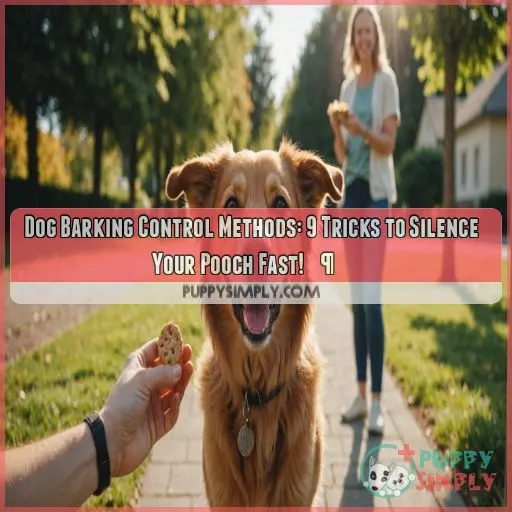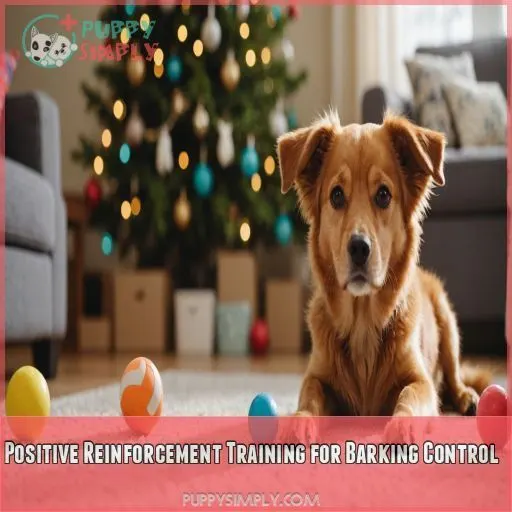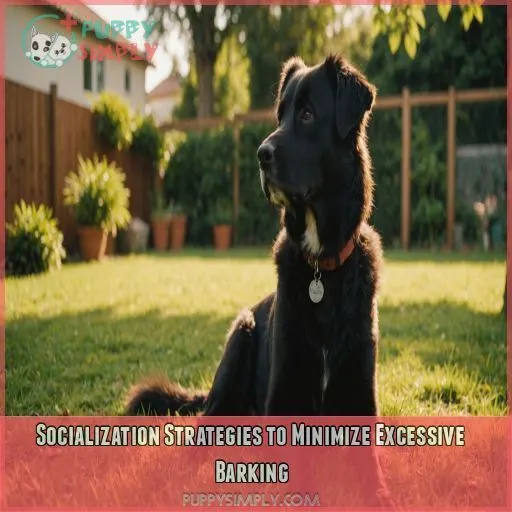This site is supported by our readers. We may earn a commission, at no cost to you, if you purchase through links.

You can start with positive reinforcement, rewarding your furry friend for staying silent.
Distraction techniques can work wonders – try Puzzle Toys or pre-emptive distractions before triggers.
For tech-savvy pet parents, ultrasonic devices or vibration collars might do the trick.
And don’t forget the power of exercise and mental stimulation to keep your pooch happily occupied.
With consistency and patience, you’ll be well on your way to a more harmonious household.
Ready to dig deeper into these bark-busting strategies?
Table Of Contents
- Key Takeaways
- Positive Reinforcement Training for Barking Control
- Effective Distraction Techniques to Reduce Barking
- Ultrasonic Devices: Silent Bark Deterrents
- Vibration Collars for Gentle Bark Correction
- Spray Collars as Quick Barking Deterrents
- Exercise and Mental Stimulation to Prevent Barking
- Socialization Strategies to Minimize Excessive Barking
- Environmental Management for Barking Control
- Teaching the Quiet Command Effectively
- Frequently Asked Questions (FAQs)
- What are methods to stop dogs barking?
- How do you stop nuisance barking?
- How do you discipline a dog to stop barking?
- How do I get my dog to stop barking at everything?
- Can certain breeds be trained not to bark?
- How long does it typically take to reduce barking?
- Are there any natural supplements to help with barking?
- Can neutering or spaying affect a dogs barking behavior?
- Do thundershirts or anxiety wraps help reduce barking?
- Conclusion
Key Takeaways
- Don’t lose your cool when your pup won’t pipe down – with patience and the right techniques, even the chattiest breeds can learn to zip it!
- Exercise and mental stimulation are your best friends when it comes to reducing barking – a tired dog is a quiet dog, after all!
- Identifying triggers is key to stopping nuisance barking, so put on your detective hat and get to work figuring out what sets your pup off!
- Consistency is king when teaching your dog the "quiet" command – stick to it like glue and reward that silence faster than you can say "treat"!
Positive Reinforcement Training for Barking Control
Want to stop your dog’s excessive barking without resorting to harsh methods? Positive reinforcement training is your secret weapon, rewarding good behavior to teach your pup when to use their inside voice and when to keep quiet.
Reward-based Techniques for Quiet Behavior
Want to turn your noisy pup into a silent angel?
Treat-based training is your ticket to peace and quiet!
When Fido clams up, shower him with goodies and praise.
It’s like teaching an old dog new tricks, but way more fun.
Consistency is key – reward every moment of blessed silence.
Soon, your furry friend will be as quiet as a mouse, begging for treats instead of barking up a storm.
Clicker Training for Bark Management
Ready to level up your bark control game?
Enter clicker training!
This nifty tool is like a magic wand for your pup’s behavior.
When your dog stays quiet, click and treat.
It’s that simple!
The key is timing – click the second your dog stops barking.
Consistency is super important, so keep that clicker handy.
With practice, you’ll be the maestro of a quieter, happier household.
Ignoring Attention-seeking Barks
Clicker training is great, but sometimes your furry friend just wants attention.
Don’t fall for it! When Fido’s barking up a storm for no reason, turn your back and give him the cold shoulder.
It’s tough love, but it works. Stay strong and consistent—your pup will soon learn that barking doesn’t equal belly rubs.
Instead, reward quiet moments with treats and cuddles.
You’ve got this!
Professional Training Assistance
 View On Chewy
View On Chewy - Assess your pup’s unique situation
- Develop a training plan just for your dog
- Teach you advanced techniques
- Provide ongoing support and troubleshooting
Effective Distraction Techniques to Reduce Barking
Looking for clever ways to curb your dog’s barking? Distraction techniques can be a game-changer, giving your pup something more interesting to focus on than whatever’s setting off their woofing alarm.
Engaging Puzzle Toys for Mental Stimulation
Now that you’ve got the basics of positive reinforcement down, let’s tackle another powerful tool in your bark-busting arsenal: engaging puzzle toys. These mental workout machines can keep your pooch’s mind occupied and their mouth shut. Here’s a quick rundown of some popular options:
| Toy Type | Description | Difficulty | Best For |
|---|---|---|---|
| Kong Classic | Stuffable rubber toy | Easy | Food-motivated dogs |
| Snuffle Mat | Fabric mat with hidden treats | Medium | Scent-driven pooches |
| Trixie Puzzle Board | Sliding puzzles with treats | Hard | Clever canines |
| DIY Muffin Tin Game | Homemade treat-finding challenge | Easy | Budget-conscious owners |
Pre-emptive Distraction Before Known Triggers
Now that you’ve got those puzzle toys ready, let’s talk about staying one step ahead of your barking buddy.
Imagine you’re a dog whisperer, anticipating Fido’s every move.
By identifying his usual triggers, you can swoop in with a distraction before he even thinks about barking.
It’s like giving him a pacifier before he starts crying.
This pre-emptive strategy can work wonders for both your sanity and your neighbors’ eardrums.
Using Toys as Training Rewards
Now that you’ve mastered pre-emptive distraction, let’s talk toys!
Your furry friend’s favorite playthings can be powerful training tools.
Think of them as doggy gold stars.
When Fido keeps quiet during a trigger, reward him with a special toy.
Mix it up to keep things exciting – one day it’s the squeaky bone, the next it’s the puzzle ball.
Consistency is key, so keep those rewards coming!
Anxiety-reducing Distraction Methods
Feeling like your pup’s anxiety is through the roof? Don’t worry, we’ve got your back!
Try cranking up some calming tunes or offering a special chew toy when stress hits.
Puzzle feeders can work wonders, keeping your furry friend’s mind off barking and on tasty treats.
And don’t forget scent games – they’re like a doggy spa day for the nose!
Creating a cozy safe space can also give your pooch a quiet retreat when things get overwhelming.
Ultrasonic Devices: Silent Bark Deterrents
If you’re looking for a high-tech solution to your dog’s barking woes, ultrasonic devices might be your new best friend. These gadgets emit a sound that’s inaudible to humans but catches your pup’s attention, helping to curb excessive barking without disrupting your peace and quiet.
How Ultrasonic Devices Work
Ever wondered how ultrasonic devices work their magic on barking dogs?
It’s like a dog whistle on steroids!
These clever gadgets emit a high-pitched sound that’s music to your ears – because you can’t hear it.
But for Fido, it’s like nails on a chalkboard.
When he barks, the device kicks in, and suddenly he’s not so keen on that vocal performance anymore.
Proper Placement and Usage
Now that you know how these devices work, let’s talk placement. Proper positioning is key to making your ultrasonic gadget sing (or rather, not sing). Remember, these aren’t magic wands – they need a clear shot at your barking buddy. Here’s the scoop on getting it right:
- Mount it at your dog’s ear level
- Make sure there’s a clear line of sight
- Keep it away from sound-absorbing materials
With the right setup, you’ll be on your way to a quieter home in no time!
Indoor Vs Outdoor Ultrasonic Options
Now that you’ve got your ultrasonic device placed correctly, let’s explore your options for both indoor and outdoor use.
Indoor devices often have a smaller range but are more discreet, perfect for apartment living.
Outdoor models pack more punch, covering larger areas like your backyard.
Some clever gadgets even do double duty, working both inside and out.
Just remember, your pup’s comfort is key!
Effectiveness and Limitations
While ultrasonic devices can be a quick fix, their long-term effectiveness varies. Some dogs may become desensitized over time, while others mightn’t respond at all. Consider these key points:
- Individual dog differences play a big role in success
- Owner consistency is really important for lasting results
- Ethical considerations should be weighed against alternatives
Vibration Collars for Gentle Bark Correction
If you’re looking for a gentler alternative to traditional bark collars, vibration collars might be your answer. These innovative devices use harmless vibrations to interrupt your dog’s barking, offering a more humane way to curb excessive noise without causing discomfort or stress.
Bark Detection Technology
Ever wonder how those bark-busting collars know when your pooch is raising a ruckus? It’s all in the tech! Vibration collars use smart sensors to catch those vocal cords in action. Let’s break it down:
| Feature | Benefit | Consideration |
|---|---|---|
| Throat Vibration | Accurate detection | May pick up coughs |
| Sound Analysis | Distinguishes barks | Background noise issues |
| Combination Sensors | Reduces false positives | Higher cost |
| DIY Options | Budget-friendly | Less reliable |
With the right collar, you’ll be on your way to a quieter, happier household in no time!
Adjusting Vibration Intensity
You’ve got the power in your hands! Adjusting your pup’s vibration collar is like finding the sweet spot on your favorite radio station.
Start low and dial it up gradually until you hit that "aha!" moment where Fido gets the message.
Keep an eye on your furry friend’s reactions and adjust accordingly.
Proper Fitting and Placement
Ever felt like you’re playing collar roulette with your pup?
Let’s get it right! Your vibration collar should fit snug as a bug, but not tight enough to make your pooch squirm.
Think of it as a comfy necklace, not a chokehold.
Position it high on the neck, where it’ll catch those bark vibes best.
Training With Vibration Collars
When training with vibration collars, start with the lowest intensity and gradually increase if needed. Watch your dog’s reaction closely – you’re looking for a gentle reminder, not a shock. Pair the vibration with a verbal command like "quiet" to reinforce the desired behavior. Consistency is key, so use the collar every time your pup starts barking excessively.
- Feel the relief as your once-noisy neighborhood becomes a peaceful oasis
- Imagine the pride of having a well-behaved pup that listens to your commands
- Picture yourself finally enjoying uninterrupted Netflix binges without barking interruptions
Spray Collars as Quick Barking Deterrents
If you’re at your wit’s end with your dog’s constant barking, spray collars might be the quick fix you’re looking for. These handy devices use a burst of air or citronella to interrupt your pup’s noisy habits, giving you (and your neighbors) some much-needed peace and quiet.
Air Vs Citronella Spray Options
Now that we’ve covered vibration collars, let’s talk spray options. You’ve got two main choices: air or citronella. Both can stop Fido in his tracks, but they work a bit differently. Here’s a quick comparison to help you decide:
| Feature | Air Spray | Citronella Spray |
|---|---|---|
| Scent | Odorless | Lemon-like |
| Effectiveness | Startling | Unpleasant |
| Duration | Instant | Lingering |
| Refills | Less frequent | More frequent |
| Best for | Sensitive dogs | Stubborn barkers |
Accurate Bark Detection Features
Accuracy is key when it comes to spray collars. You don’t want your pup getting spritzed for no reason!
Look for collars with advanced bark detection accuracy.
These smart devices use AI-powered detection and noise reduction technology to distinguish between your dog’s bark and other sounds.
It’s like having a tiny dog whisperer around your pup’s neck, ensuring only real barks get the spray treatment.
Proper Fitting and Maintenance
Don’t let a poorly fitted spray collar turn your pup into a walking sprinkler!
Make sure it’s snug but not tight—you should be able to slip two fingers under it.
Keep an eye on battery life and clean the nozzle regularly to prevent clogs.
Adjust as needed and perform weekly checks.
Effectiveness on Different Dog Breeds
Spray collars can be a game-changer for your barking buddy, but their effectiveness varies across breeds. Here’s what you need to know:
- Herding breeds like Border Collies might need extra patience due to their vocal nature
- Smaller dogs may be more sensitive to the spray, so start with lower intensities
- Older dogs might take longer to adapt, but don’t throw in the towel
- Stubborn breeds? You’ll need to combine the collar with consistent training
Exercise and Mental Stimulation to Prevent Barking
Is your dog’s excessive barking driving you crazy? One of the most effective ways to curb this behavior is by ensuring your furry friend gets plenty of exercise and mental stimulation throughout the day.
Daily Exercise Routines for Bark Reduction
Ready to turn your barking buddy into a quiet companion? Exercise is your secret weapon! A tired dog is a quiet dog, so let’s get moving. Here’s a quick guide to help you tailor the perfect workout for your furry friend:
| Breed Size | Exercise Duration | Activity Ideas |
|---|---|---|
| Small | 30-45 minutes | Fetch, indoor agility |
| Medium | 45-60 minutes | Jogging, tug-of-war |
| Large | 60-90 minutes | Swimming, long walks |
| Giant | 30-45 minutes | Slow walks, gentle play |
| High Energy | 90+ minutes | Biking, dog sports |
Indoor Activities for Mental Engagement
When it’s raining cats and dogs outside, don’t let your pup’s energy go to the dogs! Keep their mind busy and barking at bay with these indoor brain-teasers:
- Teach new tricks (old dogs can learn them too!)
- Play hide-and-seek with treats
- Set up an indoor obstacle course
- Engage in scent games like "find the toy"
These activities will keep your furry friend’s tail wagging and their vocal cords resting. It’s a win-win for both of you!
Interactive Toys for Boredom Prevention
Just like we need to exercise our bodies, our furry friends need mental stimulation too!
Interactive toys are a great way to keep your dog entertained and engaged.
Think of them as doggy brain teasers that help prevent boredom-induced barking.
There are tons of options out there, from treat-dispensing puzzles to snuffle mats.
Don’t worry if you can’t afford fancy toys, DIY options work just as well!
Try filling a muffin tin with treats and covering them with tennis balls.
Remember to rotate your dog’s toys regularly to keep things fresh and exciting.
Professional Dog Walking Services
Can’t always be there to walk your furry friend? A professional dog walker might be your ticket to a quieter pup. These canine exercise experts can help tire out your pooch when you’re stuck at work. Here’s what to look for:
- Certified and insured walkers for peace of mind
- Flexible schedules to fit your busy life
- Group walks for socialization (and a better price!)
- Regular exercise routines made for your dog’s needs
Socialization Strategies to Minimize Excessive Barking
You’ve got your pup’s barking under control at home, but what about when you’re out and about? Socializing your dog is key to preventing excessive barking in new situations, and we’ve got some tried-and-true strategies to help you both navigate the world with confidence.
Positive Experiences With Various Stimuli
Want to turn your bark-happy pup into a cool cucumber? It’s all about positive vibes!
Expose your furry friend to a smorgasbord of sights, sounds, and smells.
Start small and reward calm behavior with treats or praise.
Gradually crank up the volume or intensity of new experiences.
Soon, your pooch will be taking life’s surprises in stride, no barking required.
Introducing Dogs to Common Barking Triggers
Now that you’ve exposed your pup to various stimuli, it’s time to tackle those pesky barking triggers head-on. Introducing your dog to common bark-inducers can work wonders. Here’s how to turn those "woof-worthy" moments into yawn-worthy encounters:
- Make a list of your dog’s top barking triggers
- Start with the least challenging trigger
- Create positive associations using treats and praise
- Gradually increase exposure time and intensity
Desensitization Techniques for Reactive Dogs
Once you’ve introduced your dog to common triggers, it’s time to tackle fear-based barking.
Desensitization training is your secret weapon here.
Start with gradual exposure to your pup’s kryptonite – whether it’s the mailman or passing cars.
Keep an eye on those trigger thresholds and use positive reinforcement like treats or praise when your dog stays calm.
Environmental Management for Barking Control
Your home environment really matters when it comes to managing your dog’s barking habits. By making a few simple changes, you can create a calmer space that reduces triggers and helps keep your furry friend quiet and content.
Creating a Calming Home Environment
Creating a calming environment for your furry friend is like giving them a chill pill without the meds.
Start by playing some soothing tunes – classical music works wonders.
Set up cozy safe spaces where your pup can retreat when feeling overwhelmed.
Consider using dog-friendly decor and aroma diffusers to create a stress-free atmosphere.
Establishing consistent routines can also help your pooch feel more secure.
Blocking Visual Triggers That Cause Barking
Does your dog go crazy every time they see a squirrel?
It’s time to play peekaboo with those visual triggers!
Curtains and blinds are your new best friends – they’ll keep Fido in the dark about the neighborhood gossip.
For a more permanent solution, try dog-safe window film or creative window coverings.
These visual barriers will turn your home into a zen den, giving your furry friend fewer reasons to raise the alarm.
Using Sound Masking Techniques
Now that you’ve tackled visual triggers, let’s turn up the volume on sound masking!
You can drown out those bark-inducing noises with a little audio trickery.
Try cranking up some soothing tunes, flipping on a fan, or investing in a white noise machine.
These clever sound solutions can help muffle those pesky outdoor noises that set your pup off.
It’s like giving your dog’s ears a cozy blanket!
Establishing a Safe, Quiet Space
Your dog needs a cozy retreat, just like you need your comfy couch after a long day.
Think of it as their personal zen den!
Create a safe haven where Fido can chill out and forget about barking.
Use a crate or quiet corner, add some soft bedding, and toss in their favorite toys.
This calming atmosphere works wonders for anxiety reduction and helps keep the peace.
Teaching the Quiet Command Effectively
Teaching your dog the "quiet" command is a powerful tool in your barking control arsenal. With patience and consistency, you’ll be able to silence your chatty pooch on cue, making life more peaceful for you and your neighbors.
Step-by-step Quiet Command Training
Now that you’ve set the stage for a quiet environment, it’s time to teach your furry friend the "quiet" command.
Start by letting your dog bark a few times, then say "quiet" in a firm but calm voice.
When they stop barking, even for a moment, immediately reward them with a treat and lots of praise.
Consistency is key here, so practice this routine several times a day.
Combining Verbal Cues With Hand Signals
Want to turbocharge your "quiet" command? Pair it with a clear hand signal.
You’re speaking your dog’s language – both verbal and visual!
Try holding your finger to your lips or making a "shush" motion.
Be consistent with your gesture choice.
Some pups pick up on visuals faster than words, especially in noisy environments.
Consistent Reinforcement Techniques
Now that you’ve got your verbal cue and hand signal combo, it’s time to make it stick.
Consistency is key here, folks!
Set a regular training schedule and stick to it like glue.
Every time Fido pipes down, reward that silence faster than you can say "treat."
Clicker training can be a game-changer, marking the exact moment of quiet.
Generalizing the Command to Various Situations
Now that your pup’s got the basics down, it’s time to take your "quiet" game to the next level.
Start mixing things up by practicing in different rooms, outside, or even during your daily walk.
Throw in some distractions like a neighbor’s dog barking or the doorbell ringing.
The key is consistency – keep at it, and soon your furry friend will be a "quiet" pro in any situation!
Frequently Asked Questions (FAQs)
What are methods to stop dogs barking?
Train with treats, distract with toys, use ultrasonic devices, try vibration collars, or opt for spray deterrents. Exercise and socialize your pup to nip excessive barking in the bud.
How do you stop nuisance barking?
To stop nuisance barking, you’ll need to be a dog whisperer. Identify the trigger, then use positive reinforcement to teach your pup when to zip it. Exercise, mental stimulation, and professional help can work wonders too.
How do you discipline a dog to stop barking?
Don’t yell or punish your dog for barking. Instead, focus on positive reinforcement. Reward quiet behavior, teach the "quiet" command, and address underlying causes like boredom or anxiety. Consistency and patience are key to success.
How do I get my dog to stop barking at everything?
You’ve got a vocal pup! Start by identifying triggers and use positive reinforcement to teach quiet behavior. Increase exercise, provide mental stimulation, and consider Desensitization Training. Remember, consistency is key – you’ve got this, bark boss!
Can certain breeds be trained not to bark?
You’d think it’s like teaching a fish to fly, but even the chattiest breeds can learn to zip it. With patience and the right techniques, you’ll have your furry friend quiet as a mouse in no time.
How long does it typically take to reduce barking?
You’re in for a marathon, not a sprint! Reducing barking typically takes 4-8 weeks of consistent training. Stick with it, and you’ll see progress. Remember, every dog’s different, so patience is your best friend here.
Are there any natural supplements to help with barking?
Yep, there’s a 100% natural product called CALM-K9 that can reduce your dog’s unwanted barking, along with other benefits, and they offer a money-back guarantee if it doesn’t work for you.
Can neutering or spaying affect a dogs barking behavior?
Neutering or spaying can indeed impact your dog’s barking behavior, as it reduces testosterone levels and territorial instincts. However, it’s not a magic fix – training and addressing underlying issues are still essential to curb excessive barking.
Do thundershirts or anxiety wraps help reduce barking?
Imagine your pup wrapped in a cozy hug – that’s what thundershirts and anxiety wraps provide. By applying gentle pressure, they can calm your dog’s nervous system, reducing barking caused by anxiety and stress.
Conclusion
When life gives you lemons, make lemonade" – and when life gives you a barking dog, try these dog barking control methods!
You’ve now got nine tricks up your sleeve to silence your pooch fast.
From positive reinforcement to ultrasonic devices, remember consistency and patience are key.
Don’t be too hard on yourself (or your furry friend) if it takes time to see results.
With persistence and the right approach, you’ll be enjoying a quieter life in no time.














